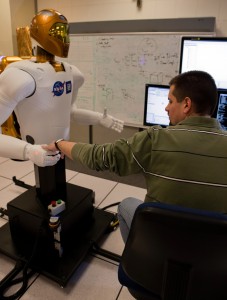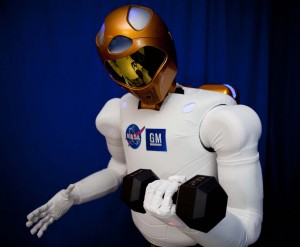He’s not quite C3PO, nor the emotional fireplug that Star Wars fans knew as R2D2, but Robonaut 2 will soon be taking his place in space as the latest resident on the international space station.
Jointly developed by NASA and General Motors, the 300-pound R2, as he’s become known to developers, is designed to see if a life-like robot can work alongside human counterparts in a variety of duties off planet Earth. (See NASA and GM Working on Robotic Technology)
R2 will actually be the second robot on the space station, though the original, Canadian-designed Dextre, is anything but anthropomorphic. It consists of two long, spider-like arms that can perform some of the exterior construction and repair work that would normally require a space walk by human astronauts.
“The use of R2 on the space station is just the beginning of a quickening pace between human and robotic exploration of space,” said John Olson, director of NASA’s Exploration Systems Integration Office. “The partnership of humans and robots will be critical to opening up the solar system and will allow us to go farther and achieve more than we can probably even imagine today.”
While R2 might look like an astronaut suited up for a space walk, GM developers stress that he not only looks human but is designed to work like one, with arms and hands that can perform the same function as living, breathing space station dwellers.

Robonaut 2 will undergo extensive testing before his launch, in September, aboard Shuttle Discovery.
For now, the prototype doesn’t have the protection needed to work outside the space station but in the future, a later version of R2 could be used to handle tasks considered too risky for human astronauts.
R2’s maiden voyage to the beyond scheduled for September aboard Discovery, on STS-133, on one of the last shuttle flights.
In the meantime, he is undergoing a series of tests to make sure he can stand up to intense vibrations, vacuum conditions and the radiation and electromagnetic levels likely to be encountered by the robot during his time aboard the space station.
Why did GM team up with NASA? The maker says it hopes that the underlying technology will eventually find its way to more earthly applications alongside human auto assembly plant workers.
“The work done by GM and NASA engineers also will help us validate manufacturing technologies that will improve the health and safety of our GM team members at our manufacturing plants throughout the world,” said Alan Taub, the automaker’s director of advanced research.
GM isn’t the only automaker pressing into anthropomorphic robot development. Honda is, in fact, better known for its long-running robot program, the maker frequently trotting out ASIMO, its own, ground-based cousin of R2D2.

